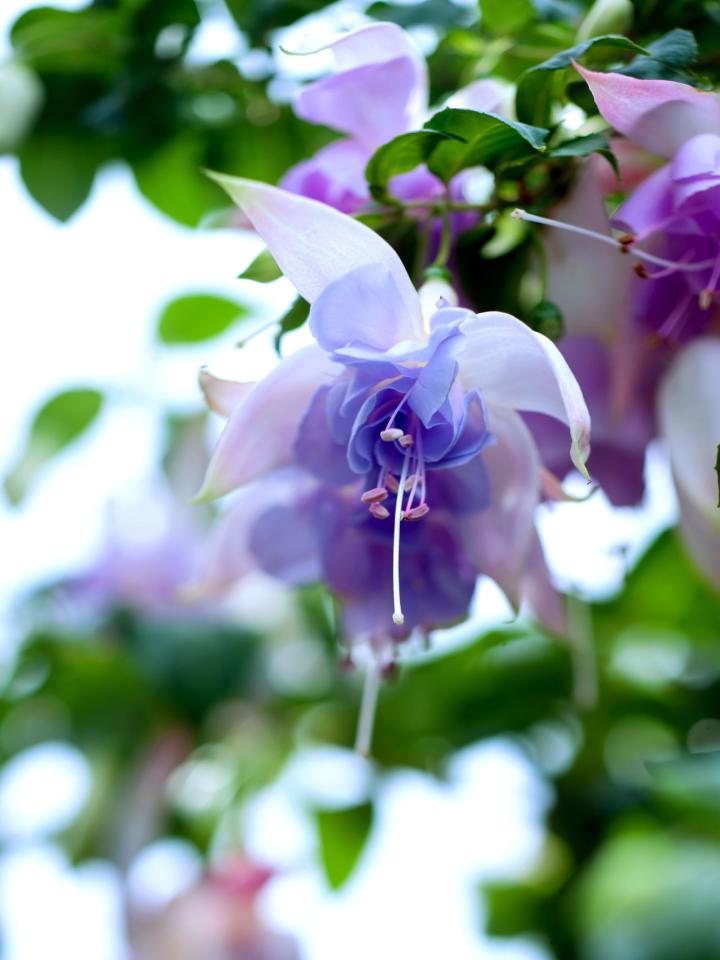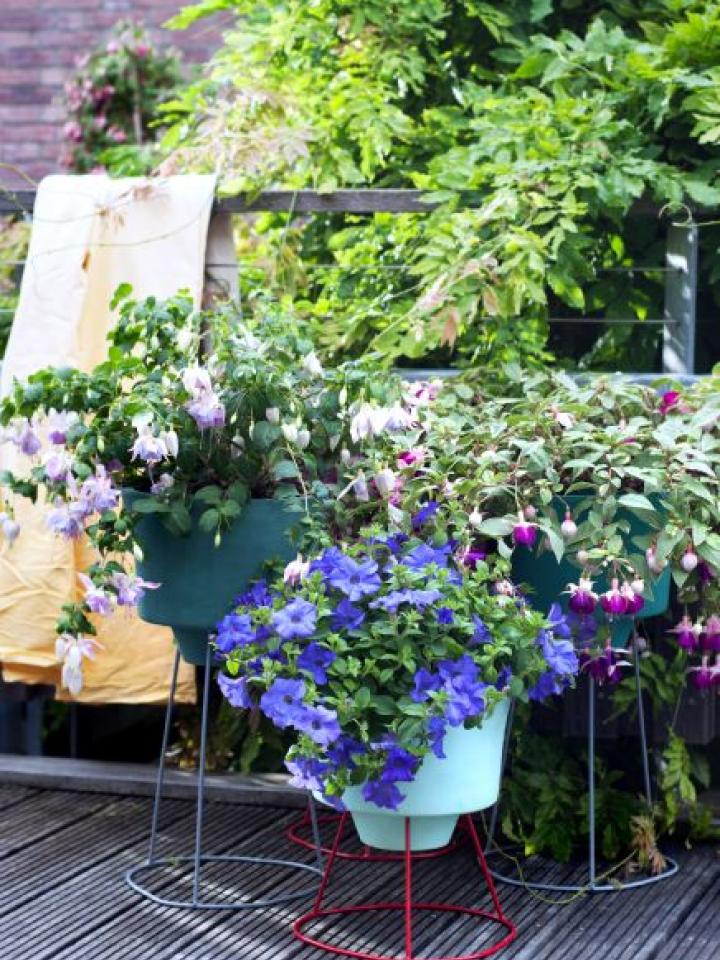FUCHSIA: CHARACTERISTICS AND FLOWERS
Fuchsia is a versatile flowering plant known for its striking blooms and vibrant colours. Fuchsias belong to the evening primrose family (Onagraceae), which also includes plants such as evening primrose and willowherb.
The fuchsia is a summer bloomer and usually flowers between June and October. The flowering peak is between July and September. Fuchsia has a special way of flowering: from bell to bell, skirt and sprites. Fuchsia starts flowering as a bell (hence the popular name bell plant) and opens as a bell. That bell then usually develops another skirt from which long sprites emerge. The undersides of those sprites are slightly thicker, as if they have pointe shoes on them, which makes each flower look a bit like a ballerina.
The colours of fuchsia are diverse. Bright pink and deep purple are the most common, but there are also red and yellow fuchsias. Fuchsia is available in many forms, such as on a stem, bush or as a hanging plant. The plant blooms for months, often well into autumn, when the flowers turn into berries. This plant isn't popular only with people but with bees and other insects too, making this garden plant is good for biodiversity.
WHAT VARIETIES OF FUCHSIA ARE THERE?
Border plant, shrub, hedge plant, tub plant, balcony plant, patio plant and stemmed fuchsia: fuchsia is versatile! There are over 100 species of fuchsia, which in turn include thousands of fuchsia cultivars. The fuchsia species vary in size, growth habit, colour and flower shape.
Roughly speaking, fuchsias can be divided into two groups: hardy fuchsias and non-hardy fuchsias. Fuchsias that can't withstand frost (non-hardy) are the large-flowering varieties that do perfectly well in a pot or hanging container. Hardy fuchsias have smaller flowers and can thrive in pots as well as in the open ground as a border plant, hedge plant or shrub. Although there are hundreds of varieties, here are the three most common ones:
- Fuchsia magellanica: this species is known for its delicate, bicoloured blossoms and is considered the most hardy fuchsia species (some varieties, such as the ‘Ricartonii’ are hardy to as low as -15°C ). Fuchsia magellanica has relatively small flowers, but the flowers are numerous and can vary in colour from pink to purple. The origin of this species is in Chile and South America.
- Fuchsia boliviana: this species is admired for its long, tubular blossoms and exotic look. Fuchsia boliviana produces large, striking flowers that are usually red or orange in colour. The flowers attract pollinating insects and can be a real eye-catcher in you garden. The origin of this species is in the Andes, Bolivia, southern Peru and northern Argentina. This species was widely used by the Incas because of the edible, black berries that emerge after the plant has flowered.
- Fuchsia x hybrida: this isn't main species, but is still worth mentioning. Fuchsia x hybrida is an umbrella term for the many hybrid fuchsia varieties. ‘Hybrida’ is frequently referred to as there are many hybrid varieties.
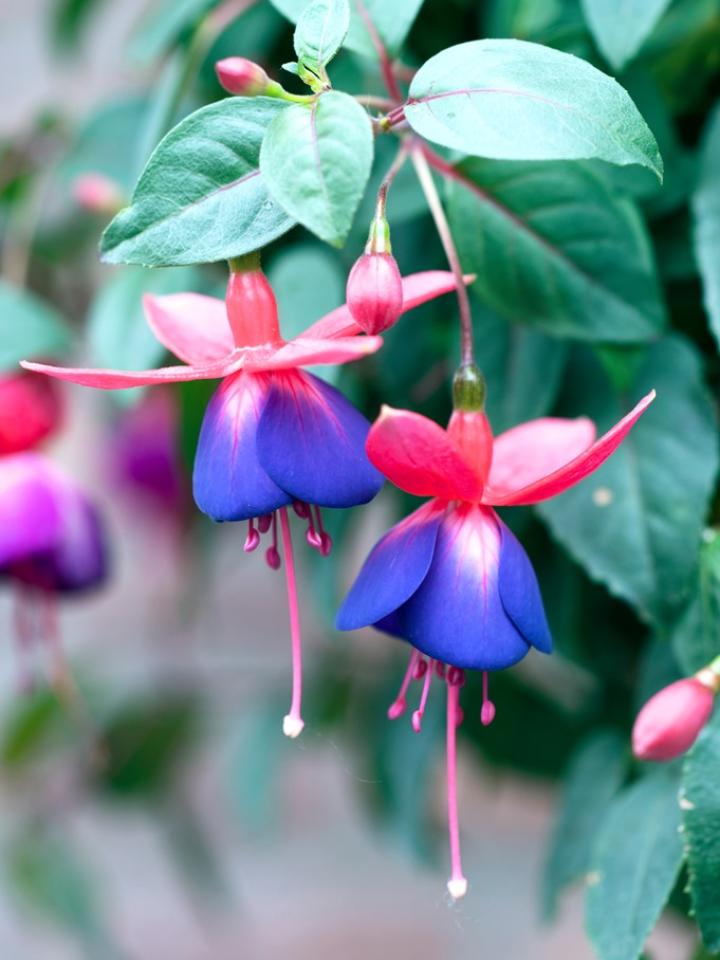
IS FUCHSIA HARDY AND EVERGREEN?
Fuchsia is not evergreen in winter - it's a deciduous shrub. Whether your fuchsia is hardy (against frost) depends on the species. Most species of fuchsia are not hardy and are therefore best kept in pots. There are also species that are hardy and are therefore better intended for the outdoors.
WHERE SHOULD YOU PLANT FUCHSIA AND HOW DO YOU TAKE CARE OF IT?
If you've planted fuchsia in your garden or on your balcony, you'll want to enjoy it for as long as possible. Discover fuchsia planting tips here and see the best fuchsia location advice and care tips below.
- Fuchsia is best planted in the spring, when the chance of frost has passed. This applies to fuchsia in the open ground and in pots.
- Fuchsia thrives best in semi-shade. They tolerate sun, but avoid a spot in the bright midday sun.
- The soil should always be slightly moist, but fuchsia can't stand soil that's too wet. Preferably, you should water at the base of the plant to prevent the leaves from getting wet (which can lead to fungal diseases).
- Give hardy fuchsias (planted in open ground) garden fertiliser and a layer of compost in spring.
- During the flowering period, give non-winter-hardy fuchsias some plant food in water every fortnight.
- Remove spent flowers from non-winter-hardy fuchsias so that the plant flowers throughout the summer.
- Fuchsias in containers need extra water in summer. Don't let the root ball dry out!
- You can overwinter a non-hardy fuchsia by putting the plant in a frost-free room at the end of October.
- Is your fuchsia getting yellow leaves? This could be due to soil that's too dry or, conversely, soil that's too wet. Check the humidity and water the plant more or less. A fuchsia plant can also develop yellow leaves if the plant has been in the same pot for too long. In this case, repot the plant in fresh soil.
- Are your fuchsia's leaves turning brown? This is probably due to too dry soil or too much bright sunlight.
- Does your fuchsia have brown spots on the leaves and/or are the flowers falling off? Then it may be suffering from rust fungus. Spray the plant with an anti-fungal agent, remove affected leaves and pay attention to your watering: not too much and not too little is ideal.
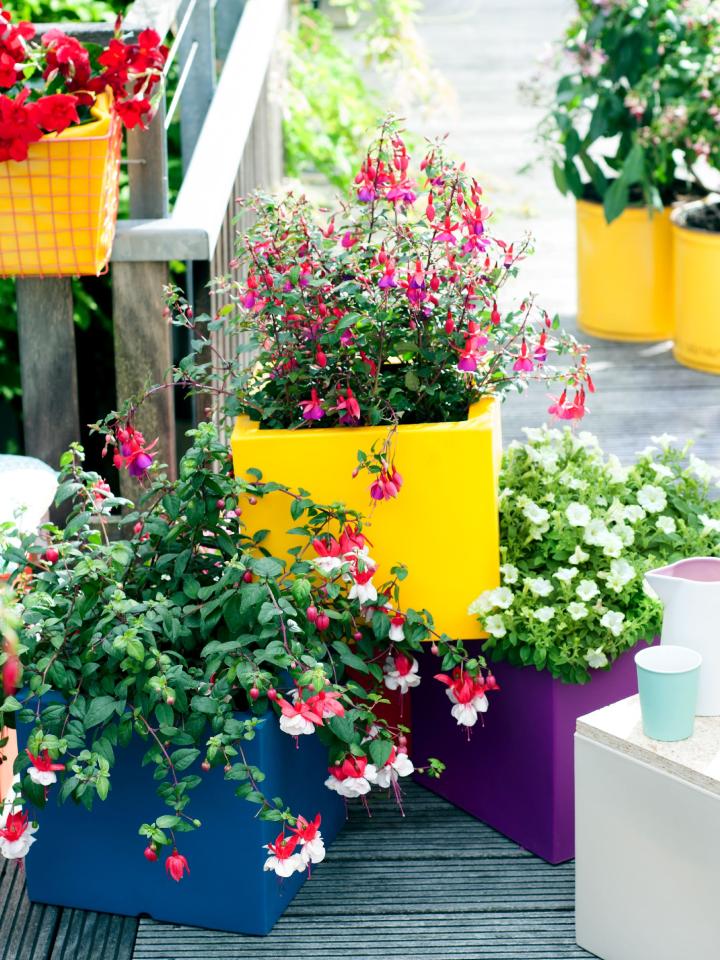
HOW TO OVERWINTER FUCHSIA
Most fuchsias aren't frost-resistant (non-winter hardy), but whether you should overwinter your fuchsia depends on the variety:
- You can overwinter non-winter hardy fuchsias from October, when there starts to be a chance of frost, in a frost-free, cool room of 5-10°C . This space should preferably be dark, as fuchsia loses its leaves in winter. The pot ball shouldn't dry out completely, but shouldn't be wet either, so make sure it's well-watered. Good spaces to overwinter your fuchsia include a frost-free shed, a cellar or crawl space. Note that attics with heating or a warm boiler aren't great spots.
- Fuchsias that are somewhat hardy, and can therefore tolerate light frost, can be brought inside during periods of severe frost, or covered or wrapped with a burlap sack or bubble wrap. Plants should never be wrapped in bubble wrap for long, however, as moisture will accumulate and mould will develop.
- Hardy fuchsias tolerate frost and can simply be grown in your garden. In severe frosts, the stems will die off above ground, but will sprout again in spring.
WHEN AND HOW SHOULD YOU PRUNE FUCHSIA?
How and when to prune your fuchsia depends on the variety (hardy or non-hardy):
- Non-winter-hardy fuchsia:
- Flowering period (summer): remove spent flowers in summer so that the plant produces new flower buds and blooms for as long as possible.
- Autumn (October): when it is time to overwinter your fuchsia, first prune the plant back by 30% and remove everything that isn't woody, before putting it in a cool, dark place. That is, remove leaves, unwooded stems and flowers. This will often leave you simply with a main branch with shortened side branches.
- Spring (April): slightly prune back your fuchsia in spring to develop good branching and a nice shape. You should also remove dead or damaged branches.
- Hardy fuchsia: prune back in spring, when the chance of severe frost has passed, and before new growth begins. Prune back fuchsia to about 10 cm above the ground. In hardy fuchsias, it's not necessary to remove spent flowers. Protect young plants from frost damage by covering them at the base of the plant with fallen leaves and/or compost. Never prune hardy fuchsias back in autumn! The branches help the plant to survive the winter.
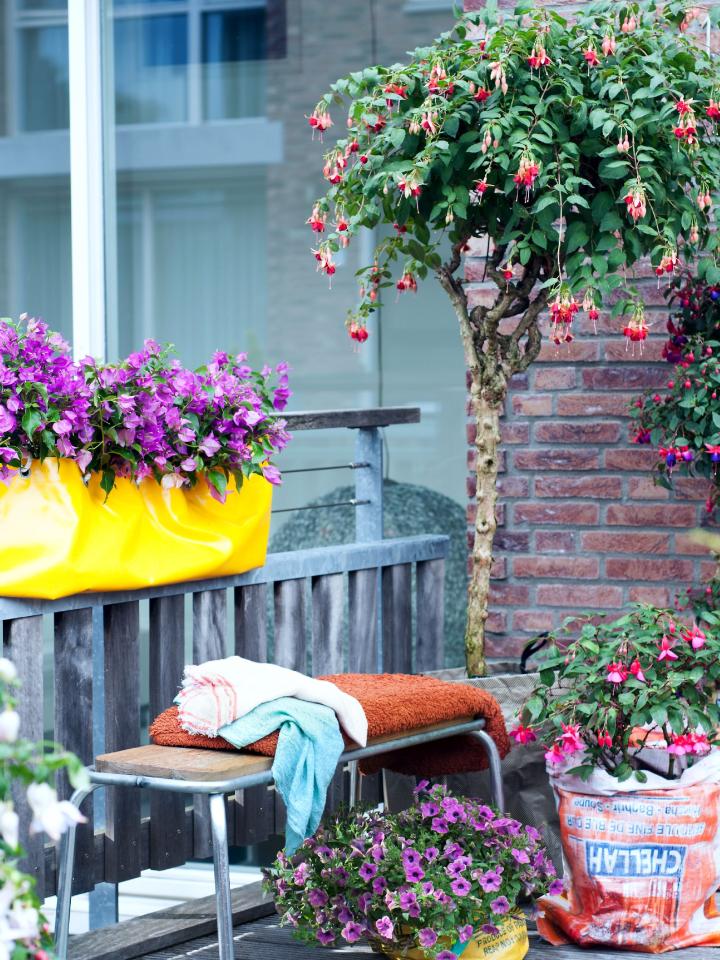
STANDARD FUCHSIA CARE AND PRUNING
Fuchsia on a stem is a very suitable tub plant for your balcony or terrace and is a true fountain of flowers! Standing fuchsia usually grows 75 centimetres to 1 metre tall and prefers a spot in the semi-shade, protected from the midday sun. Stems of fuchsia are not winter-hardy, so look after the plant pretty much the same as non-winter-hardy fuchsias: let it hibernate from the risk of frost (around October) in a cool, dry and dark place and prune the standing fuchsia back by a third. The root ball of your fuchsia on stem shouldn't be allowed to dry out during overwintering, but shouldn't be too wet either, so make sure it's well- watered. In spring (around March), you can lighten up on the plant and give it more water.
IS FUCHSIA POISONOUS?
No, fuchsia is not toxic to humans or animals. However, if your pet or child has eaten the plant, it may be advisable to consult a veterinary or doctor.
FUCHSIA SYMBOLISM
Fuchsia is a plant filled with meaning! Firstly, fuchsia symbolises elegance and beauty. The plant owes this to its graceful growth habit and beautiful flowers with delicate shapes. In addition, fuchsia is seen as the symbol of joy in life, happiness and positivity. This is thanks to its cheerfully coloured flowers, which brighten up any outdoor space and put a smile on your face.
FUCHSIA ORIGINS
The fuchsia is native to South America. A few species have also been found further north, in Central America and Mexico. In addition, some species occur naturally in New Zealand and Tahiti. Naturally, fuchsia grows in mountainous regions and moist forests, where it thrives in the shade of other trees and shrubs.
In the 17th century, the fuchsia was first described by French botanist Charles Plumier, who named the plant after German botanist Leonhart Fuchs (1501-1566), whom he greatly admired. The plant was then brought to Europe by botanists. Due to its beautiful flowers and graceful growth habit, the fuchsia soon became popular in Europe. Over the years, numerous cultivars have been developed. Today, the fuchsia is a popular garden plant worldwide, kept in pots and outdoors.
GARDEN PLANTS WITH PINK FLOWERS
Can't get enough of such dainty, pink summer bloomers? We get it! Discover these gorgeous pink garden plants that create a fairytale atmosphere in your garden, or be inspired by these pink plants for a romantic summer garden.
